Simone Severino – Strategy Sprints: Selling Your Value Proposition To Customers, Employees, And Candidates

Your value proposition is your company’s secret weapon, but how do you get it into the hands of the people who matter most? Simone Severino, the co-founder of Strategy Sprints, shares his insights on achieving market dominance while avoiding burnout. He outlines his value proposition for effective market entry, staying competitive, and becoming a leader. Simone also shares his Strategy Sprints™ Method which emphasizes setting achievable goals (90-day sprints), prioritizing tasks that contribute to success, and gathering frequent feedback to stay motivated and adapt strategies. His book, Strategy Sprints, details his coaching method for teams striving to achieve impactful business goals.
—
Listen to the podcast here
Simone Severino – Strategy Sprints: Selling Your Value Proposition To Customers, Employees, And Candidates
Introduction
Welcome to the People Strategy Forum. We’re a show that guides leaders on how to elevate the workplace. We believe people are at the heart of successful organizations. A team member’s well-being and the rewards of career development are all essential to a happy, healthy, and highly productive workforce. This show discusses the practical and effective leadership strategies for top executives, senior professionals, and talent managers overall.
On the show, we have a special guest. We’re going to dive into the heart of business agility and innovation with Simone Severino, the authority on B2B sales and the Creator of Strategy Sprints Method. Simone has revolutionized sales strategies across sectors, helping entrepreneurs reclaim valuable time and significantly boost their revenue. As an author, triathlete, and voice that resonates across platforms like TEDx and Forbes, Simone brings a unique blend of discipline in his dynamic approach to the business landscape.
He’ll share insights on how businesses can effectively sell their value proposition to customers, employers, employees, and candidates. This is a dynamic alignment that brings strategic objectives overall to the organization. Get ready to unlock the secrets behind crafting a value proposition that attracts the best people and accelerates your sales to sustain a competitive advantage for your market. Simone, it’s nice to have you on the show.
Thank you for having me.
Strategy Sprints
Simone, I would love to dive into the details about how you got to where you are now, specifically what drove you to want to write the book Strategy Sprints.
Twenty-one years ago, I fell in love with one specific big question, which was the question that I was asked by Fortune 500 companies. There are boards that would sit with me in a couple of days’ retreats. They would say, “Simone, we need a plan on how to win in the market, stay in the market, and stay 10 meters ahead of our competitor. Before we solve that, we don’t get out of here. If you need three more days and 50 more people, tell us. We’re going to fly them in.” I was like, “That’s how important this is for you guys.”
I did fall in love because people resources and attention resources are scarce things out there. I had a total commitment to this topic. How do we enter a market, stay in the market, and crush it in the market? I was like, “If this is important to you guys, I am in. I will focus on this thing for the next decades.” For the next 21 years, I did nothing else. I did fall in love with this topic. The topic evolved for over 21 years. It became more digital. We added some nuances with blockchain, AI, and all of these things that came on top.
The evergreen thing is how I enter and stay in the market. The building blocks are buyer psychology, understanding what the market is, what it needs, and the agility on our side. How can we adapt quickly around it and serve mainly that? That is what I find fascinating. I’m still doing that. With Strategy Sprints and during the pandemic, I had time to write a book about it. It became the book Strategy Sprints. It’s about what we’re doing every week, coaching people on how to crush it in a market and stay in a market. Its twelve chapters describe the experience of our clients.
Let’s dive into that a bit. What is a Strategy Sprints Method?
You break down your work into 90 days. Why 90 days? It’s because it’s small enough that you can focus on it. Think of you are preparing for your first half marathon. Ninety days is a good time to train for that. You can tell all your friends, “I’m doing that specific Boston half marathon.” You have enough time to train. These are the principles of flow that Mihaly Csikszentmihalyi found out. Make it small enough that you can do it every day. Make it big enough that it excites you. Ninety days is small enough that everybody knows what’s going on, but it’s big enough that you can accomplish one big thing in 90 days.
During those 90 days, the team consisted of one person from sales, one from operation, one from marketing, plus the designer, who was usually C-Suite or the owner of the company. That is the Sprint team. They pick three goals. We work in twelve weekly sprints towards those goals. Every seven days, we will check in and say, “Are the activities the right activities? Are we moving in the right direction at the right pace? What do we need to check? What did we learn this week? What did we fail at?” We are aiming for frequent failures so that we can invalidate assumptions. “We thought if we did this, this would happen, but it didn’t.” We have to change our assumptions. Twelve weeks and twelve sprints to achieve three goals. That’s the Strategy Sprint.
Make your work small enough that you can do it every day, and make it big enough that it excites you. Share on XYou’re coming back together with your team and saying, “What worked and what didn’t work?” In modern terms, they call it the A/B test. Is that a bit of what that is?
We A/B test everything. In those seven days, they can A/B test seven LinkedIn posts, seven X posts, seven YouTube videos, and seven landing pages. That’s why, in weekly sprints, we can find out if what we assume is what’s going on out there or not. Everything is an A/B test inside of a Sprint. You’re right. That’s the core mechanism.
Value Proposition
One of the things that I was talking about here before the show is we’re thinking about selling our value proposition as far as our product to customers and understand that. I also made the link. It was important for us to sell that same proposition to our people to ensure that they could connect the two. We’re hiring the right people to reinforce that message. When you are crafting these messages to resonate with your audience, are you thinking about what the company is about and what you are trying to solve as a society? What are the main things that come into play when crafting these messages?
We try not to craft any message but to solve problems. Is the problem to solve scarcity in computing? That’s why people need GPUs. How can we come up with GPUs? This is what NVIDIA is trying to solve, and everybody is looking at it. That was the hardware problem. The next one will be the software problem, which is starting to be the next race. Who’s solving the software problem?
The next one is water. We don’t have enough water to drink. We have water on the planet, but it’s not desalinated. The next problem will be desalination. How can we make water drinkable for everyone? We have to feed and educate people. Those are the big problems that we all as a planet need to solve. A company is a temporary way of solving or tackling those problems. Some of us are attacking the water problem, some are attacking the education problem, and some are attacking the food problem.
This is what a 90-day Strategy Sprint focuses on. I hope it answers both questions. The first question is, who are we here to serve, and what problem are we solving? That’s the market question that I focus on. People like you who are HR experts focus on the talent side and the HR side. It’s not about the message because the message is what we want them to hear.
What they’re looking at is, are these guys happy? Do they find meaning in what they do? Do they laugh? Are they continuously in the plains, living a meaningless life because they’re always in some Hiltons instead of with friends? Do they vibrate on a high vibration? Do you want to hang out with them? Are they leading meaningful conversations? Do you want your kids to hear what they’re talking about? Would you like your daughters and sons to work there? Those are the things that people are observing from the outside.
These are the things that I think we have to become more aware of. I’m not an HR expert. I focus on the activities regarding sales and marketing because this is where I see them doing many activities with low ROI. When you give a team a ton of work with low flow, with broken feedback loops, if they don’t get every seven days some form of applause or thank you, “This helped me. Please more of this,” then there is a flow element missing. If you put away the flow element, they will burn out.
Burnout looks like people are starting to smile less week by week. They show up less in the office. If they have the chance to stay home, they stay home. The Zoom meetings get more boring week by week. When there are tasks to distribute, nobody goes, “Me.” “Who’s doing that? It’s not my role.” These are the symptoms that we look for. If we see that, we know these guys have many activities on their plate. Let’s have them cut those activities in half. Find the three activities that matter and move the needle forward because otherwise, they will burn out. If they burn out, talent will run away, or no new people will apply to work for them. They will be less attractive to work for.

Value Proposition: Teams overloaded with low-flow work and broken feedback loops need frequent recognition and a sense of progress flow to avoid burnout.
Is that the next piece that you focus on in the Strategy Sprints Method? First, you’re looking at the 90-day goals and sprints. You’re putting them in a way where people are engaged. They’re doing meaningful work. They’re putting that out there. What are the other aspects of the Strategy Sprints Method that you have?
What automatically happens in a 90-day sprint is that you prioritize what is important. When you do that, you think of buyers first, and you think of the people you are here to serve internally, stakeholders and shareholders. You reduce the number of activities. We use this square, which is the focus card. You have the three-year goals, one-year goals, 90 days of activities, and three metrics. All the activities are complex in an enterprise, and the team will be on one page.
The first thing is simplification. One of the side effects of that simplification is now everybody knows who’s doing what. When you have that, you can start cutting up to 50% of all the activities that are not contributing to that three-year vision, one-year goals, and 90-day activities. By doing that alone, you bring a wave of relief into the organization because they can do in twenty hours what they were supposed to do in 40 hours. The other time, they can either do more enjoyable stuff or do additional creative tasks. That’s the first effect. How do we find the health? Which one is the health?
We map out with them their activities. You can look at the calendars and see the activities of an organization. Now we double-check. Are they contributing to these three things? Number one is increasing by 25% the price that they can charge for the same offer. If Netflix increases its price by 25% tomorrow, will you guys cancel your subscription? I will pay. My three kids are using it. They are happy. It’s $7.90 now. Would I pay 15%? They are happy, and it’s not harming them. I would pay double. Netflix is well-positioned. They can increase the price by 50% without losing clients.
That’s the positioning piece. We have to work on the positioning piece. If you get these positioning things right, in the book, I show eight specific practices to increase your positioning. If you have good positioning, you can increase by 25% the prices of your services or offers without losing your clients. That’s the first double-check of the activities.
The second double-check of the activities is whether those activities are contributing to higher win rates. You talk to ten people. Five become your clients. That’s a 50% win rate. If we can increase that, you talk to the same ten people, not doing additional lead generation or whatever big activities, just talking to the same ten people. Instead of five committing to work with you, now 7 or 8 commit to. Let’s increase the win rate by 25% in the second month of the sprint.
In the third month of the sprint, can we increase sales velocity by 25%? You have two chances at this. It doesn’t always work in the first attempt. The first attempt is at the beginning of the funnel. Can we reduce the time from awareness to closing? This can be done with video voice. You have to create fifteen valuable moments. That’s either inside or a problem solved on the other side. You can with the new technologies. Sometimes, we can’t because it’s complex B2B sales. There are eight sides on that side and nine people on the other side, plus purchasing departments. It becomes complex because of the number of people that need to be aligned, and you never get it in under eight months.
We then have to go to the other side of the funnel, which is your current clients. Can you make them happy? They came for one thing, but they stayed for something else. Let me give you an example. That’s an expansion sale, upsell, cross-sell. Let me give you an example. I signed up for an app because I have three kids, and they love mountain biking. We go mountain biking. Sometimes, they ask me, “What’s this mountain?” I say, “I have no idea.”
I pulled out my phone and tried to find out what the mountain was. This app can tell you. I downloaded the app. I forgot about it. It’s midweek. I get an email from this app. It says, “Simone, do you want some ideas about what to do next weekend?” I say, “Yeah, I need those ideas. I never have time to plan the weekend, but I need to plan it.” I always fall into the weekend without a plan, and then I’m toast. I was like, “Yes, I want an idea.” I click it. It says, “You like this mountain and that mountain. There is a mountain in between. It has a lake.” I say, “I love lakes. Let’s go there.” I click.
I signed up for Tell Me What is This Mountain? They are smart. They’re also using AI. They’re saying, “If he likes that mountain, maybe he likes that mountain.” If you hit Visit That and during the week, you don’t have time to design the weekend, you found an upsell. That’s the second attempt at increasing sales velocity by 25%. You can use your current clients and think about what else they need. Those are the three things.
That’s expanding the value proposition and making them aware. There are many situations, whether it’s customers or employees. There are situations where we have a current value proposition but they simply do not know about those options. What are the different ways that we can ensure that the customer knows these different options? You were telling us a situation where they sent a text. Let’s say they come for one value proposition, and you’re trying to open up the world to them. What are the different ways to get the message out?
First, you do a quick buyer journey. That’s the blue one that I use. I use this thing here. It asks me from the outside. What frustrates the buyer right now? What else do they need? What’s coming up for them? How can you help them be ready for what’s coming? In this case, if you are that mountain scanner app, you could go through your data and say, “How old are these people?” You find out they’re 40. They might have a couple of kids. They might be mountain biking with kids. Let’s test that assumption.
You can write a blog post to your people and say, “How was your weekend? These are some ideas for the weekend.” The click rate is if they have kids. Now that you have validated, they don’t just have a mountain naming problem. They also have a weekend design problem or an experience design problem. What if these people are busy? Let’s assume they’re busy during the week, or they don’t know how to design a great experience over the weekend. What if we send them experience ideas? You can test that quickly. It’s an assumption. Maybe they don’t care about it, or maybe they do.
You can write a seven-sentence email and test it. You send it to 1,000 people. You do an A/B. A) You should send this email about what else you can do next weekend. B) is where to find the next bike repair shop or another aviation topic. By doing that, you can quickly test this assumption. If you do that for a couple of weeks, you know the buyer’s journey. You know who these people are and what they need.
This is if you have a product. When you have a product, you are not immersed in the field. If you have a service, you know what they need. If you’re a restaurant, a consultancy, or a bookkeeping agency, you know what they need. You are immersed. I can ask you what else they need and you can tell me three things from the top of your head, “They also need this and this.” You can pick one of those and say, “How do we extend this buyer’s journey to be even more valuable for them?”
In the book, we have the tools on how to map that buyer’s journey. They’re also on our website, StrategySprints.com. People can download templates for the buyer’s journey. You can put in a couple of hours. You can map out a buyer’s journey for your buyer. This is where I would start. Invalidate and validate your assumptions with emails and directly talk to them.
Understanding the demographics of the people that you’re trying to attract and the buyer journey, what does that look like for your organization? I’d love to get your thoughts on this, Sumit. Does it seem to resonate with you? There are many parallels when we’re looking at crafting this important messaging for our customers and employees. What are your thoughts?
The earlier part of what Simone was saying was aligned with something I was reading earlier this week, which was Slow Productivity by Cal Newport. Doing fewer things and doing them well and bringing in more focus is a strong message. I was taking notes when Simone was talking. The biggest takeaway was to make it small enough for it to be doable and make it large enough to be exciting.
That’s the core of what I’m taking away from this discussion. It serves customers who are buying our product as well as the talent we’re trying to attract in that sense. There are a lot of the messages that Simone spoke about and all of these audiences are diverse. They can align with both with some modifications to the messaging. I’d love to hear what Char thinks as well.
Messaging is vital as being clear and concise. As you talked about Simone, being more strategic in your way of thinking, having more of a strategic mindset, and developing communication and strategy skills in your employees and your leaders are going to be vital. We do many things that are tactical, and we’re busy, but it’s not accomplishing the goal or achieving that triathlon or that mountain, as you talk about.
It is important to open up the calendars and look at the amount of useless meetings or meetings that aren’t contributing to the organizational mission or vision or what’s going to help the company succeed. Having those honest, crucial conversations with our employees and saying, “What are we focusing on this relative to our company goals? That’s important.
Business-To-Business Sales
I do have another question for you, Simone. When you talk business to business, oftentimes, in my experience, at least as I’m reaching out to other businesses to do marketing, I often find that each of us is busy trying to sell each other our own products. I’ve been going through this process because I’ve been trying to improve my business development strategy. I found that a lot of my activities that were tactical and talking to the wrong audience hindered my success. Even though I was busy for weeks with meetings all day long, I wasn’t achieving my goal. What do you think about that topic when we’re trying to be more our time? What do you think about that?
You’re talking about something important that I’m observing. People pitch to each other on the first chance of talking to each other. They meet on LinkedIn. They have a coffee call. It’s a pitch fest. That’s why people say, “I hate networking, ” then stop doing it. Let me give you a great example. Sam and I are in a networking group. We are running a WhatsApp group that is about networking.
A simple rule that I’ve installed there is don’t sell to each other guys. Sell through each other. Don’t sell to me. Sell through me. If you install that rule and we meet in a situation, I don’t see you as a possible immediate client, but I see you as a possible ally. What if we could be allies? My first question naturally will be, “HR, what’s your superpower? Who are your ideal clients? What is on your plate right now? What are you trying to solve? Maybe I can help.”
Don't sell to each other. Sell through each other. Share on XBy doing that, I will become empathetic. I will be listening and taking notes. I always write down when I meet somebody. What is their superpower? What are they trying to solve always? The reason is maybe tomorrow I can make an introduction because somebody else told me something that fits the puzzle. I have to say, “You have to talk. You told me this. She told me that. You guys should meet.” I make it a daily habit. I have six daily habits. One of those is to make three introductions before lunch. That’s why I ask the superpower and who your ideal client is because I will make those introductions.
I don’t start by seeing you three guys and go, “What can I sell you guys?” That’s not how you sell. You sell by understanding who they are, what their journey is, and what they need to accomplish. Over the next week, I will help you accomplish those things. In a couple of months, you guys will remember Simone. If there is an opportunity to collaborate with Simone, you might be interested, but only if I have created enough value upfront. This is what the Strategy Sprints Method is about. It’s to understand who they are here to serve and what they are doing. Help them be successful, and then your success will be a downstream effect of that.
I think that’s fantastic. I’m writing that down. I love the idea of three introductions by lunchtime. What comes to my mind, because I have a tendency to solve world hunger because I have many areas that I focus on, is that it is important to know your superpower and identify the gifts that you bring to other companies and other businesses and not make it so broad that people say, “I don’t know what Char’s.” I want to focus on. This is her area of expertise because I’ve been on a lot of networking calls, and I do that.
I’m looking for what your gift is. What’s your superpower? What do you bring to the table? I have found some are all over the board. I won’t think of that person. No offense to some people I’ve talked to, but I won’t think of that person as a potential recommendation. Do you prepare for those networking meetings?
The next important thing that I am observing is that you ask people what their superpower is and who your ideal client is. They then confuse you. Whenever I meet people, I say, “Create something like this. This is a one-pager that tells everyone. On the left side, this is my ideal client and this is who I’m here to serve. In the middle, this is what I can do for them. They can become my ally. If they want, they can introduce me to those people over the next weeks. On the right side, for people just tuning in, is who can be my ideal partner? Maybe they are the ideal partner, or they know somebody who is my ideal partner.
Create a one-pager for it. I’m a one-pager guy. I create one-pager for everything. I help my clients have a button that when you push it, there is the one-pager at the moment when you need it. Instead of presenting, I never present anything. I get asked questions. If you ask me, “Simone, who is your ideal client?” I have a button for that.
If you ask me, “Simone, can you give me an example from my industry? Have you ever worked with somebody in the size of my industry?” I would say, “What about Anthony? Anthony is in the size of your industry. I think it’s Chanel. Is she in your industry? Is she your size?” Instead of presenting, have a conversation, and you have a one-pager for things that people ask you. You are prepared. You come to a conversation, but you come prepared.
It’s sharp having those one-pagers come up. It’s relevant to the topic. There’s no delay, and you’re well prepared for that. When you’re making those introductions to others and having that clear page that shows up, it shows the audience that you’re looking for. It’s concise and easy to remember. That’s an excellent tool. Thanks for bringing that up. I’d like to know what tool you’re using to bring that up. Is that Zoom? What is that?
It’s a simple software that’s not even expensive. I can help everyone build this. If they want, go to StrategySprints.com. Hop on a calendar with me in an hour. We can build this for you. There are multiple inexpensive software that you can use. You click a button, and whatever you want pops up.
Employee Motivation
When you were talking about those 90-day sprints that we started out with, the one big piece is your people motivated to make those sprints over and over again. When we talk about it, we’re constantly in a sprint. It seems like that could lead to burnout. How do you keep your people motivated in going forward with these campaigns?
The second question is what burns you out? Is it a sprint or a marathon? If you have ever run, sprint doesn’t burn you out. You feel great after a sprint. A marathon burns you out. After a marathon, I cannot eat and sleep enough. For three days, I’m sore. After a sprint, I can do another sprint. We can go for lunch or dinner. I’m at my best. I’m glowing. I’m happy and smiling after a sprint.
If you divide work into small chunks that are exciting and intense enough, but they end on Friday, and you can measure, then you can have a weekend. The next sprint is on Monday. You can enjoy your family, your friends, or whatever you want to enjoy. The first question was, how can you keep people motivated?
I like that you say to keep people motivated. One big mistake is to think that you have to motivate anybody. You don’t have to motivate anybody. You are not a clown. You are not an entertainer. If you are a leader or a manager, your job is not to motivate anybody. They are adults. They’re motivated. Who is motivating you three guys to do this show? No one. Why? Because you’re adults. You motivate yourself.
There are some things that we can do as leaders. It’s important to say that it’s not your job to motivate because otherwise, the leaders burnout. They think they have to motivate everyone. I’m not motivating my children. I’m not motivating anybody. Everybody motivates themselves. Everybody is on your journey. Enjoy your journey. Crush it. If you need help, I’m helping you, but I’m not motivating anyone on this planet. You do you, and I help you if you ask for help.

Value Proposition: A big mistake is thinking you have to motivate anyone; everyone motivates themselves.
On the other side, can we demotivate people? Yes. There are many things that we can do as a leader to demotivate. In our meetings, if they’re boring, we are demotivating. Some meetings are even more than boring. They are unnecessary. That demotivates people. In our processes, if they’re complicated and bureaucratic. HR processes can be complicated, irritating, and demotivating if we design them that way. We can do a lot to demotivate. We can not do much to motivate.
If we understand the flow, people come in motivated. They come into our organization for a reason. We just have to keep not demotivating them. How do you do that? It’s by leaving them enough room to build what they want to build. When they come in, they have a plan. Let’s listen to that plan. Tell me about your plan. What’s your plan? How can I help you? Instead, we say, “Here is file seven FB. When it matches seven FC, you should do seven FE.” That’s demotivating people.
We say, “What’s your plan? What are you here to contribute?” That would be a better onboarding question. When they are rolling, you ask them every seven days, “Are the activities you’re doing contributing to the three-year or one-year goal? No. What do we learn? What’s your plan for next week? If we lead them this way, they will have enough freedom and autonomy.
I’ve also had some feedback loops. People need feedback loops. If I’m doing something for a month, and I don’t know if it’s working out there, I get demotivated. If I do something and after seven days, I have a feedback loop that’s telling me, “It’s helping somebody, or it’s not helping somebody.” I can keep my motivation up. You need that feedback loop.
Imagine Angry Birds. You send the pig into those birds and it says 500 points. You send the next one. It says 700 points. What do you want to do next? Send the next pig. If you send that pig, and it says, “Congratulations, in three weeks, you will get the CRM report telling you more about your results.” I’m not playing this anymore. I’m out. That’s the rule of flow that Mihaly Csikszentmihaly has found in his academic work, and we are operationalizing it using the Strategy Sprints Method.
Key Takeaways
As we come to a close here, Simone, what are the top three things that you would like our audience to remember from this conversation?
Let’s make it one so that it’s even easier. Do your buyer’s journey. Think about who your buyer is. What is on their hearts and minds right now? How can you be of service now? What else do they need? If you need a template to get smoother through this exercise, go to StrategySprints.com. Pick one of our tools so that you put in half an hour. Limit your time to half an hour, and try to learn one thing about your buyer. The person out there using your services or your products. Learn one thing about them, put in half an hour, and maybe the next day, you can reduce some activities from your plate that are not directly contributing there.
Learn one thing about your buyer so that the next day, you can reduce some activities from your plate that are not directly contributing to their needs. Share on XFuture Outlook
As we come to a close here, Simone, what are you most excited about in the year ahead? Do you have anything going on in your organization?
Our goal is to have fun as we are on it. What I’m excited about is that the book Strategy Sprints will be released in China. I’ve been to China a couple of times. I don’t know the land and the culture. I’m excited about this because there will be a new connection between China and the US, as well as China and the method. I’m curious to see how they use it. There must be something that they like about it. Otherwise, they wouldn’t have introduced it. I’m curious to find out what resonates on both sides. I’m curious to find out what happens there.
Thanks, Simone, for joining us and sharing your wisdom on Strategy Sprints. It was a fun conversation. Thank you.
Thank you, everyone.
Thank you, Simone.
Good talk.
Take care, everyone. We’ll see you on the next episode of People Strategy Forum. Thanks.
Important Links
About Simone Severino
 Severino is the co-founder of Strategy Sprints, a global consulting firm dedicated to helping businesses achieve accelerated growth through innovative strategies and agile methodologies. With a background in business coaching and a passion for driving results, Severino has developed the Strategy Sprints™ Method, which is designed to double revenue in just 90 days.
Severino is the co-founder of Strategy Sprints, a global consulting firm dedicated to helping businesses achieve accelerated growth through innovative strategies and agile methodologies. With a background in business coaching and a passion for driving results, Severino has developed the Strategy Sprints™ Method, which is designed to double revenue in just 90 days.
His expertise has been instrumental in guiding numerous companies to streamline their operations, enhance productivity, and achieve sustainable success. Severino is committed to empowering business leaders with the tools and insights needed to thrive in today’s competitive landscape.





